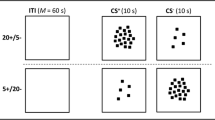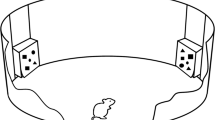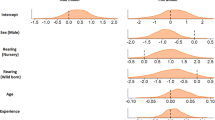Summary
Responses to variant forms of the isolation peep have been studied by behavioral techniques in a group of eight squirrel monkeys. Discrimination learning with variant pairs using shock avoidance methods was surprisingly fast, and equivalence testing without differential reward revealed that variant forms are spontaneously discriminated by captive squirrel monkeys. Evidence was obtained that features occurring in the first third of the isolation peep are more effectively utilized in choice behavior than features occurring in the last third. It is postulated that such features are part of a communicative system in this species.
Similar content being viewed by others
References
Capranica, R.R.: Vocal response of the bullfrog to natural and synthetic mating calls. J. acoust. Soc. Amer. 40, 1131–1139 (1966)
Capranica, R.R.: Why auditory neurophysiologists should be more interested in animal sound communication. Physiologist 15, 55–60 (1972)
Dewson, J.H., Wertheim, G.A., Lynch, J.C.: Acquisition of successive auditory discrimination in monkeys. J. acoust. Soc. Amer. 43, 162–163 (1968)
Kluver, H.: Behavior mechanisms in monkeys, p. 23. Chicago: University of Chicago Press 1933
Liberman, A.M., Cooper, F.S., Shankweiler, D.P., Studdert-Kennedy, M.: Perception of the speech code. Psychol. Rev. 74, 431–461 (1967)
Marler, P.: Acoustical communication. In: Mechanisms of Animal Behavior, pp. 426–479. Ed. by P. Marler and W. Hamilton. New York: J. Wiley and Sons 1966
Newman, J.D., Wollberg, Z.: Multiple coding of species-specific vocalizations in the auditory cortex of squirrel monkeys. Brain Res. 54, 287–304 (1973a)
Newman, J.D., Wollberg, Z.: Responses of single neurons in the auditory cortex of squirrel monkeys to variants of a single call type. Exp. Neurol. 40, 821–824 (1973b)
Thorington, R.W.: Observations of squirrel monkeys in a Colombian forest. In: The Squirrel Monkey, pp. 69–87. Ed. by L. Rosenblum and R. Cooper. New York: Academic Press 1968
Winter, P.: Dialects in squirrel monkeys: vocalization of the Roman arch type. Folia primatol. 10, 216–229 (1969)
Winter, P., Funkenstein, H.: The effect of species-specific vocalization on the discharge of auditory cortical cells in the awake squirrel monkey (Saimiri sciureus). Exp. Brain Res. (in press)
Winter, P., Ploog, D., Latta, J.: Vocal repertoire of the squirrel monkey (Saimiri sciureus), its analysis and significance. Exp. Brain Res. 1, 359–384 (1966)
Wollberg, Z., Newman, J.D.: Auditory cortex of squirrel monkey: response patterns of single cells to species-specific vocalizations. Science 175, 212–214 (1972)
Worden, F.G., Galambos, R.: Auditory processing of biologically significant sounds. Neurosci. Res. Progr. Bull. 10, 1–119 (1972)
Author information
Authors and Affiliations
Rights and permissions
About this article
Cite this article
Symmes, D., Newman, J.D. Discrimination of isolation peep variants by squirrel monkeys. Exp Brain Res 19, 365–376 (1974). https://doi.org/10.1007/BF00234461
Received:
Issue Date:
DOI: https://doi.org/10.1007/BF00234461




